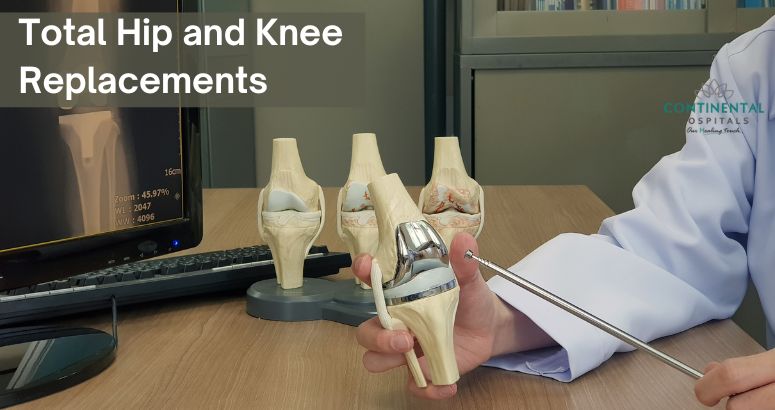- Email: [email protected]
- International Concierge : +91 995 166 0000
- General Enquiry : +91 40 6700 0000
Total Hip and Knee Replacements

Chronic hip or knee pain can significantly impact your daily activities and quality of life. Simple movements like walking, climbing stairs, or even getting dressed can become a struggle. If conservative treatments like medication and physical therapy haven't provided lasting relief, total hip or knee replacement surgery might be the answer.
Hip and Knee Pain
The hip and knee joints are marvels of engineering, allowing for a wide range of motion while bearing significant weight. However, wear and tear over time, injuries, and certain medical conditions can damage these joints, leading to pain, stiffness, and inflammation.
Common Causes of Hip and Knee Pain:
Osteoarthritis: This is the most common cause of hip and knee pain. It's a degenerative joint disease where the cartilage that cushions the bones breaks down, causing them to rub together, leading to pain and stiffness.
Rheumatoid Arthritis: An autoimmune disease that attacks the joints, causing inflammation, pain, and swelling.
Post-traumatic Arthritis: This can develop after a fracture or injury damages the joint.
Avascular Necrosis: A condition where the blood supply to the bone is disrupted, causing it to die and collapse.
Symptoms of Hip and Knee Pain:
- Pain in the hip or knee, especially during activity or at rest
- Stiffness, making it difficult to bend or straighten the joint
- Swelling or redness around the joint
- Difficulty walking, climbing stairs, or getting up from a seated position
- A popping or grinding sensation in the joint
Why Consider Total Hip or Knee Replacement?
If conservative treatments haven't provided adequate pain relief and limited your mobility, total hip or knee replacement surgery can offer significant benefits. These procedures involve replacing the damaged joint surfaces with artificial implants made of metal, plastic, or ceramic.
Benefits of Total Hip and Knee Replacement:
Pain relief: One of the primary goals of hip and knee replacement surgery is to alleviate chronic joint pain, enabling patients to experience significant relief and improved quality of life.
Improved mobility: Joint replacement surgery can restore mobility and range of motion, allowing patients to perform daily activities with greater ease and efficiency.
Enhanced quality of life: By reducing pain and improving mobility, total hip and knee replacement surgeries can enhance overall quality of life, enabling individuals to engage in activities they may have previously avoided due to joint pain and stiffness.
Long-term durability: Advances in surgical techniques, implant materials, and rehabilitation protocols have led to increased longevity and durability of hip and knee replacement implants, providing patients with lasting relief and functional improvement.
Improved joint function: Total hip and knee replacement surgeries can restore joint function and stability, allowing patients to walk, stand, climb stairs, and participate in low-impact activities without discomfort.
Correction of deformity: For individuals with joint deformities caused by conditions like osteoarthritis or rheumatoid arthritis, joint replacement surgery can correct alignment issues and restore proper joint mechanics.
Better sleep: Reduced joint pain and improved mobility often lead to better sleep quality, as patients experience less discomfort and are able to find more comfortable sleeping positions.
Increased physical activity: Following total hip and knee replacement surgeries, many patients experience a renewed ability to engage in physical activities such as walking, swimming, cycling, and other forms of exercise, which can further improve overall health and well-being.
What to Expect During Total Hip or Knee Replacement Surgery
Total hip and knee replacements are typically performed under general anesthesia. Here's a general overview of the process:
Pre-operative assessment: Your doctor will conduct a thorough physical examination, review your medical history, and order imaging tests (X-rays, MRI) to assess the damage to your joint.
Surgery: The damaged bone and cartilage are removed and replaced with artificial implants. The specifics of the procedure will vary depending on the type of implant used and the surgeon's technique.
Post-operative care: Following surgery, you'll be monitored in a recovery room before being transferred to a hospital room. Physical therapy will begin shortly after surgery to help you regain strength and mobility.
Recovery from Total Hip or Knee Replacement
Recovery from total hip or knee replacement is a gradual process. While everyone heals at their own pace, typical milestones include:
Pain Management: You'll be given medication to manage pain after surgery.
Physical Therapy: Regular physical therapy sessions are crucial for regaining strength, flexibility, and range of motion in the replaced joint.
Weight-bearing: Your doctor will advise you on how much weight you can put on the replaced joint initially and gradually increase it as you heal.
Returning Home: Most patients can go home within a few days of surgery.
Long-term Recovery: Continued physical therapy at home and following your doctor's instructions are essential for a successful recovery.
Total hip and knee replacements stand as shining examples of medical innovation, offering hope and healing to those suffering from debilitating joint conditions. As technology continues to evolve and our understanding of orthopedic care deepens, we can anticipate even greater strides in improving surgical outcomes, enhancing patient experiences, and ultimately, transforming lives. Let us embark on this journey together, as we strive to redefine the future of mobility and wellness.
.webp)
